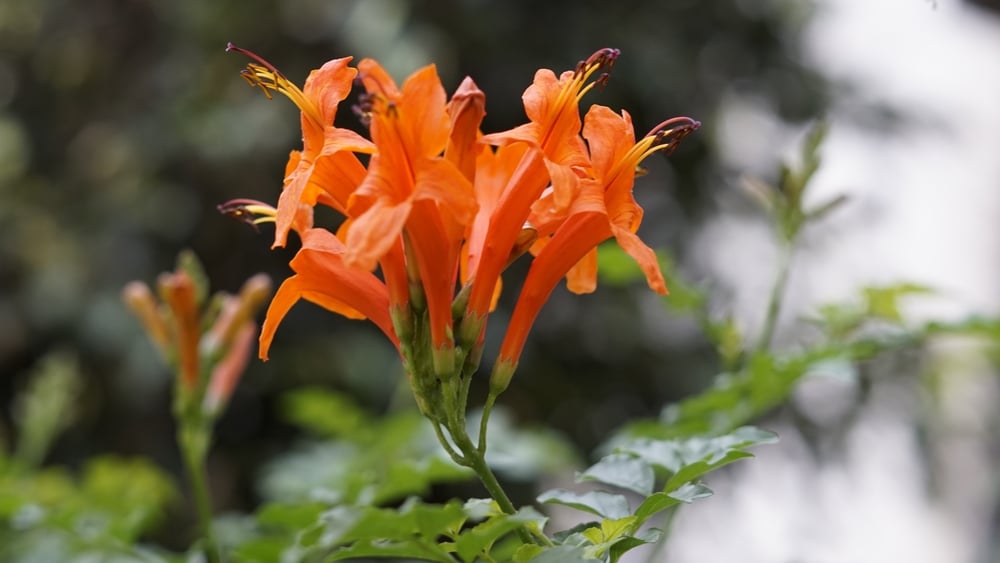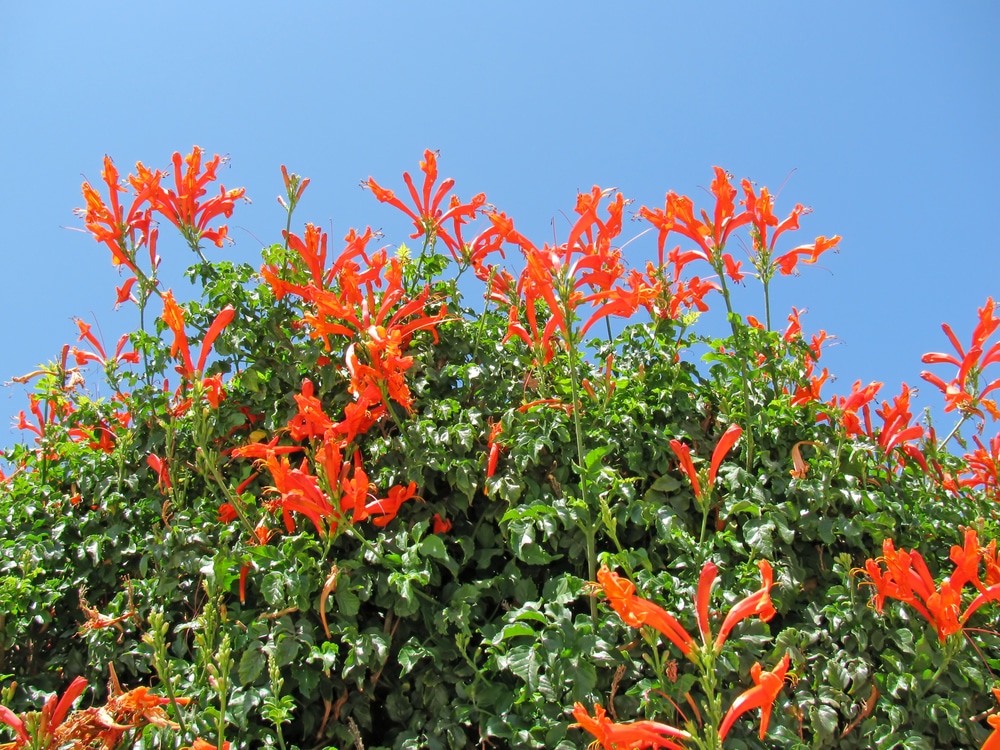Are you looking to add a bright sense of elegance to your yard? If yes, consider planting cape honeysuckle shrubs in your open yard or create a garden hedge with them. Like jewelry to your body, the gorgeous cape honeysuckle is a showstopper in any garden. Its fern-shaped foliage and clusters of trumpet-like flowers add an exquisite sense of elegance to any garden.
| Botanical Name | Tecoma capensis |
| Common Name | Cape honeysuckle |
| Plant Type | Perennial |
| Flower Color | Orange to red flowers with a shape of a trumpet |
| Size When Mature | 36 inches to 120 inches tall and wide as a shrub and 300 inches to 600 inches as a vine |
| Bloom Time | Fall to spring |
| Sun Requirements | Full and Partial Sun |
| USDA Hardiness Zones | USDA zones 9-11 |
| Soil PH Range | 5.0 – 8.0 |
| Soil Type | Acidic, or alkaline well-draining soils |
| Water Needs | Low water needs |
| Native Area | South Africa |
These plants exist as shrubs or vines. The vines can be left to grow very tall to make a thick home hedge but can be trimmed into beautiful garden flowering plants.
Whether you want to create a garden hedge or establish a thriving flowering shrub garden, it is essential to know and give cape honeysuckle the basic care requirements it needs to grow best. This article will cover more details on the cape honeysuckle shrubs and how to care for them.
What you need to know about cape honeysuckle

Cape honeysuckle are leafy evergreen shrubs that grow and spread quickly if provided with good growing conditions. Their leaves are odd pinnately with about 5 to 9 leaflets that are generally dark green, oval-like with dentate margins.
The shrubs can endure a range of lighting conditions but do best in partial to full sunlight. They are also salt and cold tolerant. In ideal conditions, cape honeysuckle shrubs usually bloom from fall to spring, producing vibrant orange and deep red flower clusters that appear more like trumpets. In warmer climates, it can bloom all year round.
The shrub grows up to 7 to 10 feet wide and tall, while the vine variety grows to a length of about 25-30 feet long and can bramble up to 50-100 feet. However, you can trim it to a width of about 5 feet and 4 to 5 feet tall. Pruning frequently can help maintain the shrubs in your best-desired shape and size.
Cape honeysuckle plants are members of the Bignoniaceae family, also known as trumpet creepers. They are native to southern Africa but have been cultivated in Singapore, Australia, Europe, India, and other parts of the world.
How to care for cape honeysuckle plants
Here is everything you need to know about growing and caring for thriving cape honeysuckle.
Light
Cape honeysuckle is a tropical shrub that grows well in either partial or full sunlight — anything more than 6 hours is okay. In their natural habitat, they have been found to grow in dappled light in the forest’s understory. In regions with extremely hot climates, the cape honeysuckle plants thrive in partial sunlight. However, it is important to know that too much shade will lead to less vigorous blooming.
Soil and water
Cape honeysuckle plants thrive in almost any soil, as long as it is well-draining. Regarding soil pH, the cape honeysuckle can thrive in both acidic and alkaline soil, with garden soil with a pH of 5.0 – 8.0 being the best.
These shrubs are salt tolerant, so they will thrive in the salty soils of the coastal regions.
Water is also essential for cape honeysuckle plants, especially when they are grown in areas receiving full sun. For cape honeysuckles growing in sunny spots, water at least an inch deep once a week. In shady spots, consider watering more sparingly. The plants will establish themselves within one year, from when they will be able to endure drought conditions.
Temperature
Cape honeysuckles thrive in USDA hardiness zones 9- 11 and are heat resistant. They can withstand temperature drops to 25 degrees Fahrenheit, below which their leaves and branches start to die back.
Fertilizer
While cape honeysuckles do not necessarily need fertilizer to thrive; you can feed them with a well-balanced fertilizer yearly. Before applying fertilizer, make sure to have your soil tested by a local agricultural extension officer, who will then recommend the ideal fertilizer.
Common diseases
Cape honeysuckles are hardy with literally no common diseases. However, you may see spider mites or whiteflies eating the plants if kept indoors for a long time.
Propagating
The plant produces suckers that aid its self-propagation. However, you can propagate it with softwood cuttings or the same plant’s suckers.
To propagate with suckers, wait until the suckers have naturally rooted in the soil and clip the stem connecting it to the main plant. Afterward, you can dig it up and move the plant to any other place of your choice.
For propagation with soft wood softwood cuttings, use sharp pruners to clip about 5-inch long cuttings. Trim the leaves, leaving just a few top leaves. You can also scrub out some bark if it is too woody. Dip the cuttings in a rooting hormone and plant them in pots filled with standard potting mix.
Place the pot in an area with about 70 to 80 degrees Fahrenheit and place a plastic bag to cover the top, so it helps retain moisture. The roots will be established in about 14 days to 14 weeks with adequate light. You can now transplant to your most preferred planting site.

